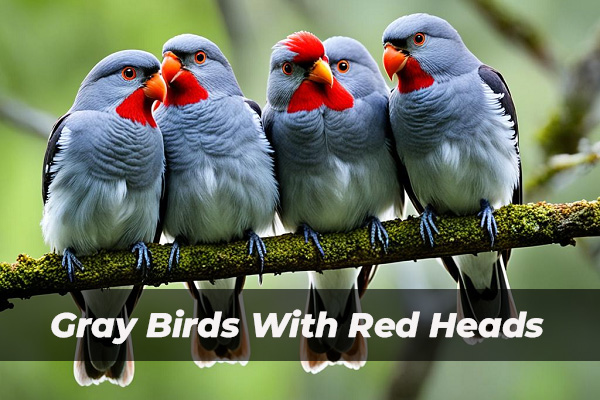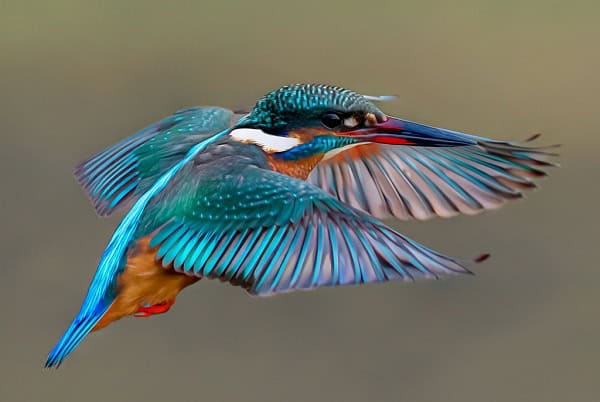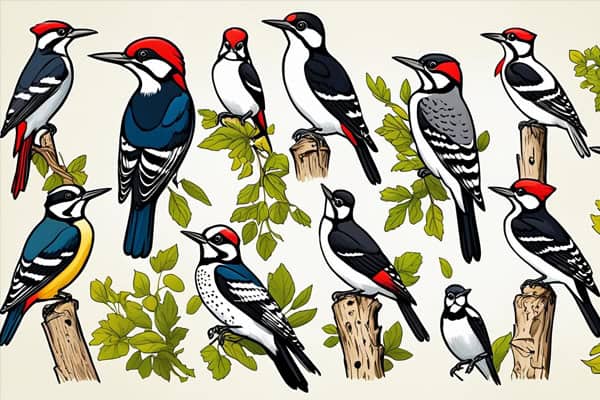8 Types of Geese in Florida (ID Guide With Photos)
Did you know Florida is home to over 8 types of geese in winter? These birds live in the state’s wetlands, lakes, and parks. They catch the eye of nature lovers and bird watchers. From the Canada goose to the Egyptian goose, each type has its own look and way of living.
This guide will teach you how to spot these amazing geese in Florida. You’ll see the Snow goose, Greater White-fronted goose, Ross’s goose, Brant goose, Cackling goose, and sometimes the Barnacle goose. With beautiful photos, you’ll learn about their homes, what they eat, and when they visit.
Understanding Geese in Florida
Florida is home to many types of geese because of its diverse ecosystems. These birds are key to keeping the environment balanced. Watching them can make your bird watching better and teach you about their lives.
About eight out of thirteen goose species in North America live in Florida, from fall to spring. They come back to their favorite spots, adding to the state’s rich wildlife. It’s interesting to see how they live with other birds, finding food and raising their young.
Bird watching helps us learn about these amazing birds. By watching their movements, nests, and eating habits, we learn a lot about Florida’s ecosystems. It also shows why we need to protect their homes, so future generations can enjoy Florida’s birds too.
1. Canada Goose
The Canada goose is a bird you can find in many places, especially in Florida. It stands out with its looks and can live in different places. Here, you’ll learn about its scientific name, where it lives in Florida, and what it eats.
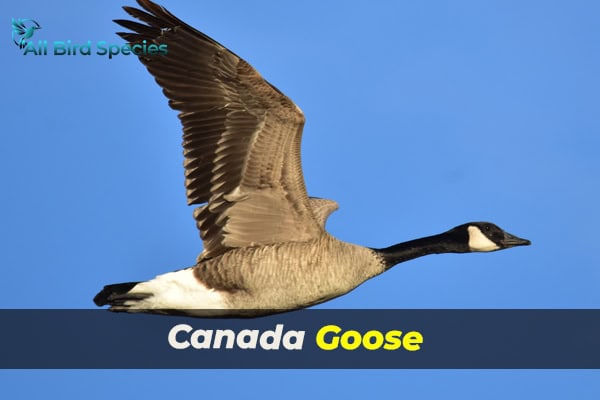
Scientific Classification and Identification
Its scientific name is Branta canadensis. The Canada goose is between 30 to 43 inches long and weighs 7 to 14 lbs. It has a big wingspan of up to 71 inches. You can tell it apart by its black head and neck with a white chinstrap and a brownish-gray body.
Habitat and Distribution in Florida
In Florida, the Canada goose lives in places like lakes, rivers, parks, and even cities. They stay in Florida all year. In winter, they come together in big groups, especially near water for food and rest.
Diet and Feeding Habits
Canada geese mostly eat plants near water and in the water. They also eat in cities, looking for food in parks and farms. This helps them survive in different places in Florida.
| Attribute | Details |
|---|---|
| Scientific Name | Branta canadensis |
| Length | 30 to 43 inches |
| Weight | 7 to 14 lbs |
| Wingspan | Up to 71 inches |
| Habitat in Florida | Lakes, rivers, parks, urban areas |
| Diet | Grasses, aquatic plants |
2. Egyptian Goose
The Egyptian goose (Alopochen aegyptiaca) is known for its unique look and behavior. It has features that catch the eye. Bird watchers and nature lovers find it fascinating.
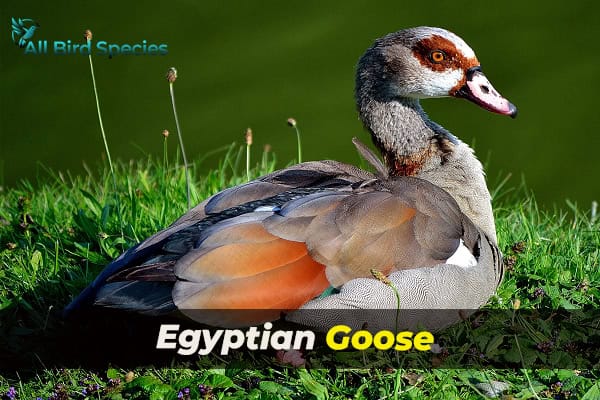
Distinctive Features and Appearance
The Egyptian goose has chestnut and white feathers with dark eyes. It also has a reddish-brown collar. This makes it stand out. They are about 24 to 29 inches long and weigh 3.5 to 6.6 lbs.
Nesting Habits and Reproductive Behavior
Egyptian geese like to nest in cavities or old nests. They line their nests with feathers and plants. The female lays up to twenty-two eggs.
After the eggs hatch, the young need help but learn to feed fast. Watching them helps us understand how they reproduce.
3. Snow Goose
The Snow goose, known as Anser caerulescens, is a fascinating bird. It has traits that make it stand out. Learning about its beauty and variations will make you appreciate it more in Florida.

Characteristics and Variations
Snow geese are 25 to 32 inches long and weigh 3.2 to 6.5 lbs. They are famous for their pure white feathers and black wingtips. There’s also a “Blue Goose” phase with darker feathers, which looks different from the usual ones.
This variation can sometimes confuse people. But it shows how Snow geese adapt to different places.
Migration Patterns and Seasonal Presence
Migration is key for Snow geese. They come to Florida from October to April, looking for marshes and fields. Their long migration to the Arctic tundra is amazing.
They form big groups during breeding seasons. This shows how well they adapt to different climates.
Learning about the Snow goose’s traits and migration can make birdwatching in Florida better. Seeing these birds in nature is a special experience.
Related Video:
4. Greater White-fronted Goose
The Greater White-fronted goose is known as Anser albifrons. It stands out in the bird world with its unique looks and where it lives in Florida. Learning about its looks and where it likes to be can make you appreciate it more.
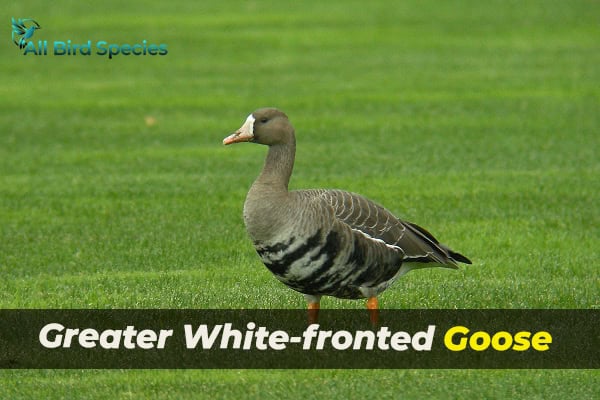
Size and Physical Description
This bird is 20 to 30 inches long and weighs 2.7 to 6.6 pounds. It has a gray-brown body with white marks on its face. These marks help people distinguish it from other birds.
Preferred Habitats in Florida
These geese are like places with lots of food and shelter in Florida. They are not as common as some other geese but can be seen in winter at:
- Marshes
- Lakes
- Agricultural fields
They eat grasses, grains, and plants, so they do well in areas with lots of these foods.
| Characteristic | Description |
|---|---|
| Length | 20 to 30 inches |
| Weight | 2.7 to 6.6 lbs |
| Coloration | Gray-brown body with white facial markings |
| Common Habitats | Marshes, lakes, agricultural fields |
| Diet | Grasses, grains, and other plants |
5. Ross’s Goose
When you’re out in nature, you might see Ross’s Goose. It’s a beautiful bird with unique looks and ways. Knowing how to spot Ross’s Goose can make birdwatching more fun.
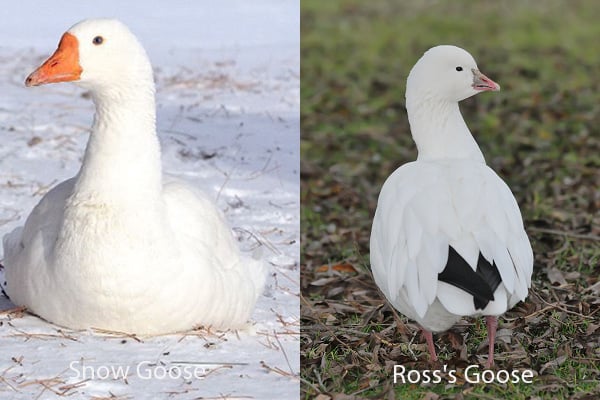
Identification and Distinguishing Features
Ross’s Goose is smaller, about 20 to 25 inches tall. It’s all white, which makes it stand out. Its short, pink bill is a key way to tell it apart from other geese like the Snow Goose. Here are some key things to look for:
- Distinctive all-white plumage
- Short, pink bill
- Smaller body size compared to Snow Goose
Behavior and Feeding Patterns
Ross’s Geese like to eat in fields, especially when they’re moving to a new place. They eat grasses and grains left behind. Watching them, you’ll see they like to be with other geese, like Snow Geese, during their big moves.
| Feature | Ross’s Goose | Snow Goose |
|---|---|---|
| Size | 20 – 25 inches | 26 – 34 inches |
| Plumage Color | All-white | White with black wingtips |
| Bill Color | Short, pink | Long, varied (white or blue) |
| Feeding Habitat | Agricultural fields | Wetlands, fields |
6. Brant Goose
The Brant goose, known as Branta bernicla, is a medium-sized waterfowl. It is between 21 to 25 inches long and weighs 2.2 to 4.6 lbs. Its dark head and neck stand out against a light gray body. There’s also a white patch on the neck.
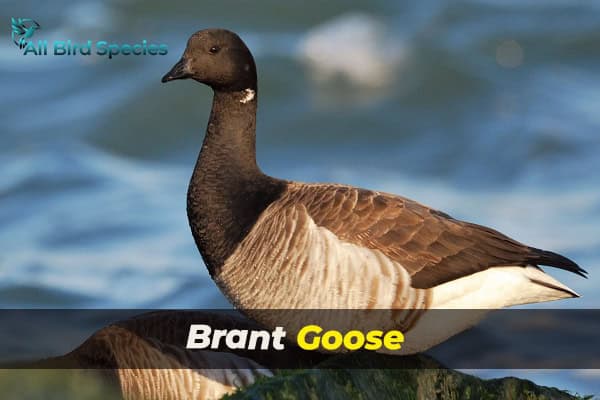
Appearance and Size
Learning about the Brant goose can help you spot it more easily. Its dark head looks great against its light body. The goose’s shape and size make it stand out during birdwatching.
Migration and Wintering Habitats
Brant geese migrate from the Arctic to North America for the winter. They go to coastal areas, wetlands, and farms for food. Seeing them in these places is thrilling for bird lovers.
Learning about the Brant goose shows how diverse birds are. Its unique look and migration make it vital in winter ecosystems.
7. Cackling Goose
The Cackling Goose is often mixed up with the Canada Goose. This mix-up helps birdwatchers tell them apart. The Cackling Goose is smaller and has a thicker neck. These differences make it easier to spot them.
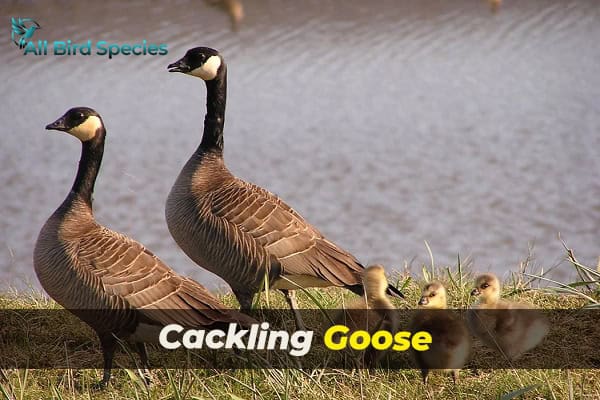
Comparison with Canada Goose
Looking at the Cackling Goose, you’ll see it’s different from the Canada Goose:
- Size: Cackling Geese are smaller, weighing 3 to 6 pounds. Canada Geese can weigh up to 14 pounds.
- Neck Structure: The Cackling Goose has a thicker, shorter neck.
- Vocalizations: Its calls are higher than the Canada Goose’s deep honks.
Habitat Preferences in Florida
In Florida, Cackling Geese like the same places as Canada Geese. They live in:
- Wetlands
- Parks
- Areas with lots of grass
- Places near water
| Feature | Cackling Goose | Canada Goose |
|---|---|---|
| Size | 3-6 pounds | 10-14 pounds |
| Neck Length | Short and stocky | Long and slender |
| Vocalization | High-pitched calls | Deep honks |
| Preferred Habitats | Wetlands, parks | Similar to Cackling Goose |
8. Barnacle Goose
The Barnacle goose is a bird with striking black-and-white plumage. It has a short neck and sharply defined markings. These features make it stand out from other geese. If you’re lucky, you might see one in Florida.

Barnacle geese live in the north but come to Florida during migration. They don’t stay long, but their visit is special for bird lovers. Seeing a Barnacle goose is a treat for anyone who loves birds.
| Feature | Description |
|---|---|
| Coloration | Black-and-white plumage |
| Neck Length | Short neck |
| Habitat | Northern nesting regions |
| Migration | Seasonally appear in Florida |
| Size | Medium-sized goose |
Where to Find Geese in Florida
Geese in Florida live in many places. Knowing where to look and when helps you see them. Look for them in wetlands, state parks, and urban lakes. In winter, they come together in big groups, making it easy to see them.
Best Locations and Times
Some top spots for seeing geese in Florida are:
- Lake Kissimmee State Park
- Paynes Prairie Preserve State Park
- St. Johns River
- Big Cypress National Preserve
- Local urban lakes, especially in winter
The best times to see geese are early morning or late afternoon. This is when they are most active.
Interaction with Other Avian Species
Geese live with many other birds in Florida. Watching them with ducks, shorebirds, and raptors is interesting. They work together when eating and resting, making birdwatching fun.
| Location | Type of Habitat | Best Time for Viewing |
|---|---|---|
| Lake Kissimmee State Park | Wetlands | Winter Migration |
| Paynes Prairie Preserve State Park | Freshwater Marsh | Fall and Winter |
| St. Johns River | Riverine Wetlands | Year-Round |
| Big Cypress National Preserve | Swamp | Winter Migration |
| Local Urban Lakes | Freshwater Lakes | Winter Months |
Conservation Status of Geese in Florida
Keeping geese healthy in Florida means knowing about their conservation status and how to protect them. It’s important to understand the laws that help these birds. This way, they can live well despite many challenges.
Protection Measures and Legal Status
In the United States, geese are under laws that protect them during their migration. It’s illegal to hurt or catch them without permission from the U.S. Fish and Wildlife Service (USFWS). Conservation efforts are key to keeping goose numbers stable and strong in Florida.
Challenges Facing Goose Populations
Goose populations face big challenges, like losing their homes due to cities growing and land changing. Climate change makes things worse by changing where they can live and how good those places are. Also, rules about hunting need to be watched closely to keep goose numbers healthy. It’s important to tackle these issues to make sure geese can still be found in Florida.
Interesting Facts About Geese
Geese are fascinating creatures with complex social structures and rich cultural backgrounds. They show amazing group behaviors that show their strong social bonds. Watching these behaviors can give you a peek into their daily lives and how they interact.
Group Behaviors and Social Structures
One of the most interesting facts about geese is their strong family ties. They often travel in tight family groups. This shows their cooperative parenting, making sure young goslings are looked after by everyone.
Their migratory patterns are really interesting. They fly in the iconic V formation. This not only makes them more energy-efficient but also brings them closer together.
Cultural Significance and Myths
Geese have been seen as symbols of loyalty and vigilance throughout history. In many cultures, they are celebrated in myths and stories. Their loud honking does two things: it warns others in the wild and was also used in the past for military and home purposes.
Learning about their cultural significance helps you appreciate these amazing birds more.
Check our Previous Articles:
| Colorful Hummingbird Flowers |
| Sparrows in Indiana |
| Woodpeckers of Indiana |
| Sparrows in Georgia |
| Swallow-Tailed Kite Identification |
Final Thoughts
Learning about the different geese in Florida makes birdwatching more exciting. It also helps us understand the challenges these amazing birds face. These waterfowl are key to their ecosystems. Knowing their unique traits makes us value their role in Florida’s varied habitats more.
Birdwatching helps spread the word about saving their homes. Every time you see a goose, you’re reminded of nature’s balance. It shows why we must protect these amazing birds and their homes.


